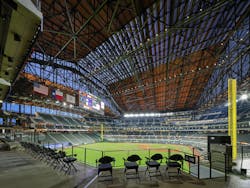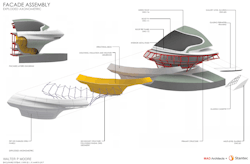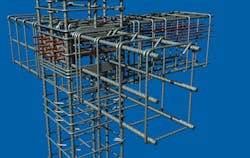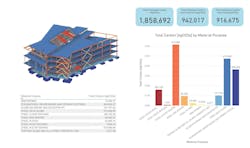7 game-changing trends in structural engineering
Exciting and unique buildings increasingly dot the landscape of our urban environments and beautifully fill the pages of our design magazines. Conversely, over the past half century the construction industry has “been slow to adopt new technologies” and “has undergone no fundamental change,” according to the World Economic Forum.
The built environment, which consists of construction plus real estate, represents almost $6 trillion in U.S. GDP per year. It is the largest industry in the U.S. Compared to industries such as automotive, aerospace, and manufacturing, however, construction lags significantly in productivity growth and R&D spending. Are we falling behind the innovation trajectory of other industries? What are the reasons our industry has struggled to evolve with respect to productivity? Is technology keeping pace in AEC?
While the industry works to tackle these questions and issues, there are many firms experimenting and pushing the envelope in compelling ways. In the realm of structural engineering, innovation is occurring at the grass roots level by professionals who are exhilarated by technology and continually incorporating creative new ideas. The following are seven key areas where innovation in structural engineering is driving evolution.
1. Integrated Digital Platform
The AEC industry utilizes technology for processes such as advanced structural analysis, modeling of complex geometry, and schedule planning. However, the industry overall is poorly connected from a digital standpoint across firms and across platforms. A typical building project might have a team of six to 10 design consulting firms, and a contractor with 10−20 subcontractors interacting with the ownership team. Each of these entities does important work with varying levels of technological sophistication, but the level of technology connectivity within each entity and between entities is often rudimentary at best.
Several highly specialized firms in the structural engineering space are creating their own integrated digital platforms that allow them to communicate seamlessly internally and with project partners. These platforms involve a community of tools, processes, and people that facilitate and drive the flow of data, information, and knowledge across their delivery systems. This goes beyond using Revit to model a structure in 3D and sharing that model with subconsultants. This also goes beyond having a small group of specialists who create bespoke software tools to improve design. These digital platforms are broad, and the engineers, modelers, and project managers are working constantly in building information modeling (BIM).
At these high-performing firms, tools such as Rhino and Grasshopper are ubiquitous in every design office because teams utilize visual programming and parametric modeling as core processes. At Walter P Moore, for example, we have a team of programmers/engineers who are writing and updating programs to transfer data from analysis programs, Revit, Tekla, Rhino, and others to a central database. This central database allows us to keep metadata and to add metadata as the data flows from program to program. This process transforms simple data into powerful, fabrication-ready information that can be served up for designers, clients, and contractors. This is game-changing in the AEC industry and will drive project delivery evolution for the future.
2. Visual Programming and Parametric Modeling
Design programs have been used by engineers for decades to design building elements. The scope of these individual design programs is quite narrow, and there is little or no connectivity to the hundreds of other design processes that take place on every project. Engineers design beams in one program and then manually transfer key information to drawings or to BIM. They use spreadsheets to design footings, pile caps, and dozens of other structural components and then transfer critical data from one place to the next. Savvy engineering firms have their own in-house programming capabilities that allow them to customize or mold commercially available software, or to create their own programs that do what they need to do.
Visual programming provides an avenue to improve this tremendously. Platforms such as Grasshopper offer a visual programming interface that allows the programming logic to be readily seen, understood, and implemented. Visual programming can be leveraged broadly, which allows engineers to write simple programs that connect disparate processes and improve the speed and the efficiency of the design process. This process improvement is exciting and rewarding for staff, and it provides value to clients on every project.
An additional benefit of visual programming is that it allows a firm to rapidly expand their parametric modeling capabilities. Parametric modeling refers to the process of establishing parameters of a design that are allowed to be variable, setting criteria for how those parameters can vary, and then running multiple analyses to obtain the final design of the system over the entire range of parameter steps. For example, this process can be used to vary the depth and spacing of steel trusses over an airport terminal such that the steel tonnage is minimized. This type of parametric modeling allows users to analyze multiple options for clients in real time. Once the parametric model is created using a visual programming platform, engineers can iterate options in seconds and the information can be shared visually with clients.
3. Advanced Model-Based Deliverables
BIM provides the ability to create 3D content and has become the standard of the industry for the built environment. The assumption could be made that all design teams are providing high-quality 3D content that can be used robustly for construction. However, that is not the case. There are a few reasons for this:
- Liability concerns by design teams of handing over electronic BIM information are significant.
- There is a difference in modeling building components in BIM for general coordination versus modeling with the precision needed for an electronic deliverable. Small imperfections in model geometry or metadata can create significant problems if that information is relied upon by a contractor.
- Oftentimes, only primary building components are modeled in the design phase with no integration of secondary members and no detailed modeling of complex member connections.
- BIM programs that are used for design are different from the programs used by subcontractors for fabrication.
The disconnect between the potential of BIM and the status quo represents a major opportunity for improvement. Some structural engineering firms in the AEC space are tackling this gap by taking the steps necessary to create advanced model-based deliverables. This requires modeling in BIM delivery programs such as Revit with precision that can be relied upon, including both primary and secondary members, complex geometry, and connections.
An extension of this improvement is for structural engineers to work directly in fabrication-level programs such as Tekla, which allows engineers to provide information to subcontractors in the language and format they need. To realize the full potential of these advanced model-based deliverables, they must be transmitted to the contractor and be relied upon for construction.
Many structural engineers and architects are not ready for these steps, as the risks are apparent. However, the benefits of building virtually via model-based deliverables and coordinating with the contractor before structural materials show up on site are clear. Fewer changes in the field, better control of structural quantities, and reduced (or zero) change orders are some of the important outcomes that are being realized in this process.
4. Integration of Multiple Services with Core Structural Engineering
Specialization in AEC has fueled the development of deep expertise among individual consultants, which has allowed engineers and architects to push the boundaries of design. At the same time, however, specialization has also hardened boundaries between disciplines and created the potential for scope gaps and coordination issues. Some structural engineering firms are bridging these gaps by expanding their scopes, including disciplines beyond structural in their core delivery, and providing a more integrated design.
Oftentimes, the basic structural engineering scope stops at primary members and the edge of slab at each level of the building. However, by taking the additional responsibility for designing and delivering all secondary members, and by including steel connections, embed plates, and cladding supports, the scope of the full structural system is delivered. Some firms are adding robust enclosure design services, including optioneering of materials and systems, design of cladding members, and modeling of core cladding components. This creates a much more robust delivery of the entire building core and shell and allows for greater coordination.
The addition of services such as erection engineering, especially for complex structures, ensures that the design intent is followed through all the way to construction. Additionally, high fidelity modeling of rebar in concrete structures or of structural steel buildings can also expedite the transition from design to shop drawings to construction.
The inclusion of specialty services such as threat and risk assessment and mitigation, and designs to resist extreme loadings, protection from blast, progressive collapse, and other potential threats creates more holistic design solutions.
Firms that can combine these design services in an integrated fashion bring immense value to their architectural clients, owners, and contractors.
5. Sustainable Design
Sustainability in the built environment is an important concern for our generation and for generations to come. Structural engineers have engaged in this issue so minimally in the past that few expect us to be experts with solutions to share. This is changing rapidly. Structural engineers are responsible for specifying and designing most of the mass and a significant percentage of the cost of every building. The impact that we are having on sustainability is profound.
Understanding embodied carbon and leading conversations about the impacts of design decisions is critical. Structural engineers are in the driver’s seat to understand the impact of material choices and system decisions. Gone are the days when the structural engineer’s contribution to sustainability discussions was limited to utilizing fly ash in concrete.
The first step for designers is to truly understand embodied carbon—where it originates, how buildings impact the amount of carbon in the environment, and the consequences of excessive carbon in the atmosphere. The second step is to accurately know and robustly track the quantities of structural elements. The third step is to develop workflows as designers that allow us to analyze and understand the effects of material choices by connecting quantities to programs such as Tally and Embodied Carbon in Construction Calculator (EC3). The last step is to engage with this information throughout the design process, provide structural options for evaluating carbon impact with other important design factors, and serve as experts in making recommendations to the overall design team and the owner.
Engineers that provide material quantity tracking of structural—and enclosure—materials within their models and in their deliverables provide a two-fold benefit to the project. First, the material quantity tracking can feed into the measurement and tracking of embodied carbon in the structure. Secondly, they communicate to the owner, estimators, and builders the evolution of the material quantities—and hence costs—throughout the design process. The transparency of generating and sharing this information is of benefit to the project.
In 2020, several structural engineering companies became signatory firms that are leading the SE2050 Commitment, with a goal of achieving substantive embodied carbon reductions in the design and construction of their projects.
6. Performance-based Design in Seismic, Wind, and Fire
With the goal of providing safe buildings to protect the public, building codes have evolved to focus heavily on prescriptive design. This approach involves strict requirements on structural design process, materials, strength, and detailing. The current code-based approach provides life-safety performance level of structures. However, this prescriptive approach does not allow structural engineers to take varying design paths to attain code-level performance, nor does it distinguish between higher levels of performance. As structural engineers, we are attempting to weave multiple goals together for the overall design safety, code compliance, constructability, serviceability, reliability, first cost, and life-cycle cost. To truly accomplish this, alternative approaches are sometimes required.
Performance-based design (PBD) is the concept of starting with the end goal as the primary goal (i.e., the performance level), and then using analysis, simulation, and testing to demonstrate that a structure will meet that performance level. This process may draw heavily on concepts in prescriptive design, but it also allows for innovation and targeted solutions for unique problems. PBD can fuel innovation and it can create tremendous value for a client. Highly qualified design firms with top-notch analysis capabilities and deep expertise are required to ensure that PBD is implemented correctly. PBD is not an answer for every building, but for the right projects—complex, tall, iconic, or important—PBD is the right solution.
A primary implementation of PBD is to target performance objectives related to a specific hazard, with seismic, wind, and fire being at the forefront of the hazards to tackle. Seismic design has a strong history over the past couple of decades of creating viable paths to PBD. Clearly defining the probability of seismic shaking, determining the performance of the structure being designed, allowing the structural engineer to design the right solution for the goal, and implementing a peer review process are all critical steps in the implementation of PBD for seismic.
The wind design community has followed the lead of its seismic counterparts and has made strides along this path recently. In 2019, the American Society of Civil Engineers (ASCE) released a pre-standard for PBD Wind, setting the stage for a comprehensive approach to alternative design for wind loading. This alternative approach allows for the evaluation of safety, performance level, building drift, occupant comfort, and response to extreme wind events.
PBD for fire is in its infancy stage, but the applicability of being able to target designs for fire performance could be extremely broad. The Charles Pankow Foundation provided a large grant for advanced research in this area, and in 2020 ASCE published Performance-Based Structural Fire Design: Exemplar Designs of Four Regionally Diverse Buildings Using ASCE 7-16, Appendix E.
7. Use of New Materials and High-performance Fabric
For many years, the palate of core materials for structural engineers has been very stable. Concrete, steel, masonry, and wood have been the main building blocks for generations. At the same time, there are exciting things happening on the fringes of these core materials that are providing new design avenues for engineers, architects, and owners.
Innovative ways to use timber is one such example. The drive for more sustainable buildings has helped mass timber become an extremely sought-after material choice. With this drive for more mass timber, advances have been made in several areas: building codes have allowed expanded use of mass timber systems, fire resistance has been researched in more depth, and innovative systems such as cross-laminated timber (CLT) have opened new avenues for design implementation.
Another example is the growing use of high-performance fabric in buildings. Structural fabric is a high-end material that derives its form and its strength from tension. By combining structural support elements with fabric, engineers can design engaging and innovative building cladding, roofs, and canopies. Material choices for the fabric can provide the ability to vary the amount of light transmission from clear to opaque and can allow designers to tune characteristics such as flame resistance, weather resistance, and strength.
The future will provide opportunities to evolve the current generation of fabrics by allowing designers to increase the strength of fabrics and be able to tune the UV transmission without impacting the ability to see through the fabric.
Structural engineers are an important part of the design and construction industry, and many of the exciting changes in how we work are fueling innovation in the built environment. With continued use of technology in designing and documenting our work, forward-thinking use of materials, and enhanced collaboration with design and construction partners, we will continue to improve outcomes in our building projects.
About the Authors
Mark Larsen, PE, SE, is a Managing Principal and Director of Operations of the Structures Group at Walter P Moore. He can be reached at [email protected]. Blair Hanuschak, PE, SE, is a Managing Principal and Executive Director of the Structures Group at Walter P Moore. He can be reached at [email protected].




